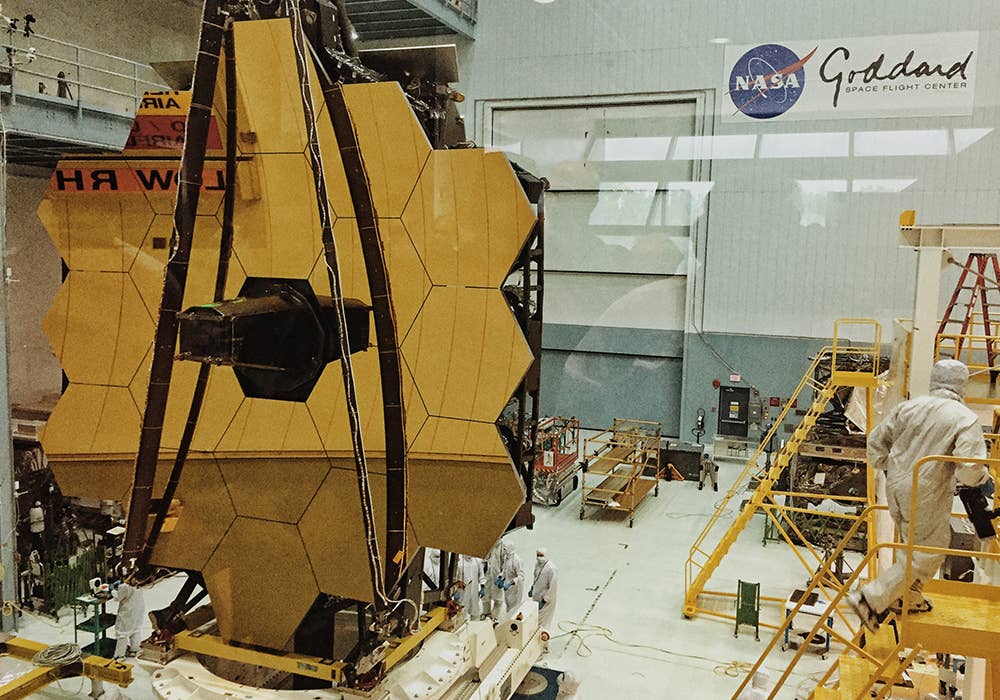What You Need to Know About the James Webb Telescope
The massive JWST, as it’s called, has been decades in the making and is scheduled to launch on Christmas Eve.

The JWST was conceptualized as the successor to the Hubble Space Telescope. Courtesy: NASA
The world is on the brink of a new age of space exploration, thanks to the decades-long development of NASA’s James Webb Space Telescope (JWST). Packed with cutting-edge technology, the massive telescope is set to launch next week.
But what makes the JWST so important? And why has it taken so long to produce? With those answers and more, here’s everything you need to know about the JWST.
Originally known in 1996 as the “Next Generation Space Telescope,” the JWST was conceptualized as the successor to the Hubble Space Telescope.
NASA, with the help of European and Canadian Space Agencies, set out to build a machine capable of seeing the very first stars and galaxies that formed after the Big Bang. The JWST, renamed in 2002 after NASA’s second administrator, James E. Webb, was poised to become the world’s most powerful infrared telescope.
Construction of the JWST began in 2004, beginning nearly 20 years of collaboration between three different space agencies. According to NASA, more than 300 contributors from around the world helped turn the idea into a reality.
While the JWST is NASA’s most powerful telescope to date, it doubles as its largest—thanks to its array of primary mirrors spanning 6.6 meters in length.
The telescope’s mirrors are a daunting feat on their own. The 18-piece hexagonal mirror intercepts light traveling through empty space, bouncing it back into Webb’s secondary mirror.
Each of the primary mirrors are coated with gold, measuring 100 nanometers thick—about 1/1000 the thickness of a sheet of paper. Setting itself apart from Hubble’s aluminum-coated mirror, the JWST’s gold coating allows for light on the lower-end of the electromagnetic spectrum to be captured by the telescope’s instruments.
Why is that important? When light travels across the universe, it loses energy and slowly moves toward the lower end of the spectrum—aptly named “redshift.” Since the JWST will be able to capture these faint beams of light, the telescope will essentially look back in time to the very beginnings of our universe.
In order to catch infrared light from across the galaxy, the JWST will also have to protect itself from light and heat emitted from our sun, Earth, and moon.
Contributing to the telescope’s unique shape, the JWST is equipped with a five-layer heat shield that spans nearly the size of a tennis court. Each layer acts as shade for the mirrors and sensors, keeping the instruments extremely cold at approximately minus 390 degrees fahrenheit.
Even with its massive sunshield, the telescope will have to travel a million miles away from Earth to block the sunlight reflecting off our planet, and the moon, simultaneously.
Luckily, there’s a perfect spot for just that. The “Lagrange Point,” or L2, is an orbit that keeps the Sun, Earth, and moon behind the spacecraft without leaving their gravitational pulls. The European Space Agency (ESA) has already placed its own telescope, Planck, in L2 to collect radiation from the Cosmic Microwave Background (CMB).
In addition to all the aforementioned technology, the JWST is packed with several technological advancements compared to Hubble—but getting it to its destination remains the mission’s largest hurdle.
Like the world’s most complicated origami, the telescope will have to fold into the fairing of the ESA’s Ariane 5 rocket.
By normal standards, the Ariane 5’s payload fairing is huge, packing a 4.57-meter diameter and 16.19-meter-long space—barely enough to fit the gigantic Webb telescope. The Ariane 5 has proven to be a reliable launch vehicle, having 80 successful consecutive launches as of 2017.
According to NASA, the JWST will take two weeks to unfold its mirrors, sunshield, solar panels, and miscellaneous instruments once in space. Given the extremely delicate nature of the materials used throughout the telescope, NASA only has one shot to get everything right.
Previously, NASA astronauts have been able to repeatedly make repairs on the Hubble, but the same won’t be possible for Webb, given its million-mile distance. It will be the slowest two weeks for many of NASA’s engineers.
The launch was originally scheduled for December 22, but was delayed to Christmas Eve. The Ariane 5’s launch window opens at 7:20 a.m. ET from Arianespace’s ELA-3 launch complex near Kourou, French Guiana.
Given its proximity to the equator, the launch site provides the added benefit of using the Earth’s spin as a slight boost to the spacecraft’s momentum.
For up-to-date information on the JWST, visit jwst.nasa.gov, or follow @FLYINGmagazine on Twitter for continued coverage.

Sign-up for newsletters & special offers!
Get the latest FLYING stories & special offers delivered directly to your inbox






